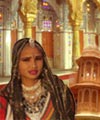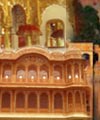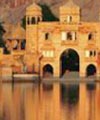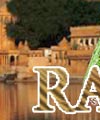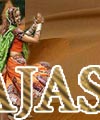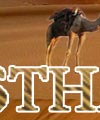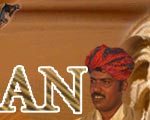|
Fairs & Festival
The people of Rajasthan live life to the hilt and nobody can really
match the gay abandon with which the Rajasthani surrenders himself
to the numerous fairs and festivals that are celebrated here . There
are animal fairs, there are religious fairs and there are fairs
to mark the changing seasons. In fact, celebrations occur almost
round the year and provide the visitor with the splendid opportunity
to gain an insight into the life of Rajasthani . There is dancing,
singing , drama , devotional music and other community activities
that can enthrall the visitor.
Listed here is a very small selection of the countless number of
exciting events that are held in Rajasthan throughout the year.
Details of these and many other other religious and seasonal festivals
are available with the Rajasthan Tourism offices throughout the
country.
Kite Festival (Jaipur, 14 January)
Makar Sakranti , the kite flying festival is spectacular.Everything
closes down and the kites are flown from every roof top and street
. The object is to bring down other’s kites , attempting to
the deafning cheers and loud music of huge crowds . the sky remains
dotted with vivid splashes of colors , as kills in a variety of
hues , shapes and sizes dart across the azure blue.
Camel Festival (Bikaner , January)
A unique celebration highlighting camel and cultural heritage of
northern Rajasthan . The camel festival begins with a colourful
procession of bedecked camels against the red sandstone backdrop
of Junagarh fort , the festivity advances to the open sand spreads
of the grounds , followed by the best breed competition , the tug
of war contest , camel dances and acrobatiess . The camels dance
gracefully to the slightest direction of their trainers – their
bejewelled necks , jingling anklets cast a magical spell . Glorious
Gorbandh dance , local folk performes and dazzling fireworks offer
a different tenor and tempo altogether.
Nagaur Fair (Nagaur , Jan-Feb)
Essentially an animal fair is one of the largest in the country
. The fair is renowed for the trading in cows , bullocks , camels
and horses . Mirchi Bazar is the main attraction and wooden items
, ironcraft and leather accessories are available in plenty during
the fair. Top
Desert Festival (Jaisalmer , Jan-Feb)
A spectacular event
coinciding with the full moon in Jan/Feb. The rich culture of the
region is on display during this three day long festival.
The famous Gair and Fire dancers are the major attractions of the
celebrations. Interesting contests including a turban-tying competition
and a Mr. Desert contest further enhance the fun of the occasion.
A trip to the Sam sand dunes marks the grand finale, where one can
enjoy camel rides and brilliant performances by the folk artistes
under the full moon against the backdrop of picturesque dunes.
Bhaneswar Fair (Dungarpur , Jan-Feb)
A religious festival with simple and traditional rituals . Quaint
rhythms conjure up the tribal cultural identity of the Bhils of
the Rajasthan , Gujarat and M.P . Bhaneshwar means the master of
the delta and this name was given to the Shival linga. The Bhaneshwar
fair is held at a small delta formed by the river Som and Mahi and
prayers are offered to Lord Shiva locally named as Bhaneshwar .
The fair resounds with the gaiety of traditional folk songs , folk
dances and Rasila animal show , magic shows acrobatic feats . Adding
to
the excitement are the joy rides on mery go round and swings.
Elephant Festival (Jaipur , March)
A magnificent spectacle , it unveils the majesty and grandeur of
elephants ,celebrated around Holi . The Mahawats or owners proudly
decorate their elephants with bright colours , Jhools(saddle cloth)
and heavy jewellery. a royal procession of decorated elephants ,
a match of elephant polo , an elephant race and playing Holi on
elephants are main events.
Top
Brij Festival ( Bharatpur , March)
Held on the eve of Holi in honour of Lord Krishna , the festival
is marked by verve and zest villagers , in gay multitued attire
can be seen singing and performing the Rasilla dance the immortal
love story of Radha and Krishna.
Gangaur Festival ( Jaipur, March-April)
A festival devoted to Goddess Parvati, the consort of Lord Shiva.Ishar
and Gangaur are the divine male and female who embody marital love.
dedicated to the Goddess Gauri (Parvati) , the festival commences
on Holi. young girls pray for grooms of their choice while married
women seek a long life for their husbands. The ladies decorate their
hands and feet by drawing designs with Mehendi (Myrtle paste ).
Festivites continue for 18 days culminating with the arrival of
Lord Shiva to escort his bride home. A grand procession with the
idle of Gauri in beautifully decorated gold and silver a palanquin
caparisoned elephants , camels , horses , dances , drummers and
joyous children
, goes through the city streets . A sweet dish called Ghewar characteristic
of the Gangaur festival is distributed among friends and relatives.
Mewar Festival (Udaipur, March-April)
The Mewar Festival in March-April is the ceremonial welcome to spring
and is dedicated to goddess Parvarti. A procession of colourfully
attired women,carrying images of the goddess to the Gangaur Ghat
of the Lake Pichhola is the major highlight.Songs,dances and firwworks
displays mark the festivities.
Top
Kaila Devi Fair (Kaila-Karauli,March-April)
The temple of Kaila Devi populary known as Mahalakshmi (the goddess
of wealth) is the venue of fair lasting for a fortnight . Kaila
Devi has been regarded as the guardian deity throughout the ages
by the Khinchis and Yadavs and the princess of Karauli. The ritual
of Kanak Dandoti is observed by staunch devotees . Groups of Mina
tribemen arrive in a spirit of gaiety dancing , singing and and
creating a lively atmosphere.
Shri Mahavirji Fair ( Chandangao , March-April)
Followers of Mahavir Swami –24th Tirthankara Saint of digambar
Jains come from far and wide to pay homage at the shrine at Chandangao
. There is a Manstambha (tower of glory) made of marble in front
of the temple . The pilgrims gather at the temple to worship , mediate
and seek the blessing of the Saint . The image of Mahavirji is washed
early in the morning , the ritual called prakashalan . This is followed
by pujan and evening aarti . The fair reaches its peak when the
image of the deity is taken to the bank of river Gambhiri in grand
procession for Kalash Abhishek .
Summer Festival (Mount Abu , June)
The summer season is the time for exuberant festivities in this
sylvanretreat of Rajasthan. The hill town , covered with mango groves,
beautiful bauhinia trees and thickets of wild berries , stirs with
life in the first week of June every year .Tribal festivities ,
folk and classical music performances amidst the lush surroundings
and lovely lakes , make it a joyous event .
Top
Teej Fair
(Jaipur , July-August)
The festival celebrating the reunion of Shiva and Parvati , is celebrated
at the onset of the monsoon . Teej is the festivalof swings . Young
girls and women dressed in green clothes sing songs and swing in
celebrating the advent of the monsoon . An elaborate procession
is taken out in Jaipur for two consecutive days with ornately dressed
elephants , horses and camels , bands performing artists and colourfully
dressed people . Goddess Parvati is invoked to bless her worshippers
with conjugal harmony and bliss.
Gogaji Fair (Gogamedi , Aug-Sept)
Gogaji fair is held in the memory of the popular hero of the area
who is known as Goga Veer amongst the Hindus and Jahar Peer (Saint)
amonst the muslims. Gogaji is popular as a Snake God and almost
every village in Rajasthan has a Than (sacred place) dedicated to
him . The idol of Gogaji is seated on a blue horse with a snake
coiled around the neck. An inscription in persian can be seen at
the main entrance which describes Mohmud Ghaznavi’s regard
for Gogaji. Many people can be seen singing and dancing carrying
multicoloured flags called nishans in their hands.
Kajli Teej (July-Aug)
The celebrations of the festival are different than the usual Teej
festivities.Unlike Teej,which is celebrated on the third day of
the month of Shravana,Kajli Teej is celebrated on the third day
of the month of Bhadra.
An exuberant procession of Teej in a decorated palanquin starts
from the beautiful Naval Sagar and culminates at the Azad Park.
Cultural performances by the local artistes as well as by the artistes
from Hadoti region are part of the celebrations. Though the Teej
procession is carried out for only two days, the festivities continue
till the eight day, finally ending on Janmashtami, the birth anniversary
of Lord Krishna. Top
Ramdev Fair (Ramdevra-Pokran , Aug-Sept)
Regarded as the incarnation of Lord Krishna by Hindus and and venerated
by Muslims also as Ram Shah Pir , Baba Ramdev was a Tanwar Rajput
and a saint who had miraculous powers. He believed in the equality
of all human beings and helped the downtrodden by granting them
their wishes. The Ramdeva fair is attended by hundreds of thousands
of devotees irrespective of their caste , creed and religion. These
groups organise night long singing of bhajans and kirtans to pay
homage to Baba. Ramdevra village lies about 12 kms. from Pokran
in Jaiselmer district and can be reached from Jodhpur and Pokran
by bus and rail.
Marwar Festival (Jodhpur , Oct)
The two day long colourful extravaganza celebrating the ‘Maand’
style of folk music brings out the romantic lifestyle of Rajasthan’s
rulers. Folk artistes performing under the full moon bring alive
the legends and the folklores of the area.
Pushkar Fair (Pushkar-Ajmer , Nov)
Excitement , gaiety and a keen sense of competition fill the air
as the long journey to Pushkar begins . The only temple dedicated
to Lord Brahma (the creator) is located at Puskar . The Pushkar
lake is surrounded by 52 flights of steps called ghats . Pushkar
is among the five principal places of Hindu pilgrimage . People
consider the water of Pushkar lake to be very sacred and he ritual
of taking dips in the holy water is believed to bestow salvation.
It is customary to float lighted eastern lamps placed on pattals
(plates made of leaves) on the waters of the lake .
In conjunction to religious fair , a cattle fair is also organised
. The highlight of the Pushkar fair is the trading in camels .
URS (Ajmer)
The Urs ,a commorative celebration is held in the solomen memory
of Khwaja Muin-nd-Din-Chisti, a prighly respected sufi saint fondly
revered as benefactor of the poor, popularly known as Gareeb Nawaz.
The Dargah Sharif in Ajmer , is the place where the saints mortal
remains lie burried and is the site of the largest Muslim fair in
India.Chadar , Ghilapg and Neema which are votive offering for the
tomb are offered by several hundred thousands devotees . Mehfils
and Qawwalis are held and mass prayers calls for the eternal peace
of the mankind. An interesting ritual is looting of Kheer ( Milk
Pudding) which is cooked in two large cauldrons called Degs and
distributed to the devotees as tabarruk (Blessed food).
Top
Info on Fairs and Festivals of Rajasthan - india
|
